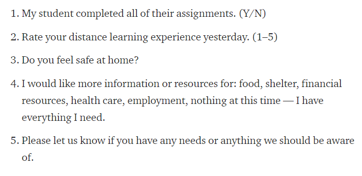Remote Learning 2.0: Using Data to Understand What’s Working
By Julie Kennedy and Charter School Growth Fund

As remote-learning plans get off the ground across the country, the conversation is shifting from “How are we going to keep teaching?” to “How will we know if it’s working?”
Here are a few lessons learned by high-performing public charter schools as they identify new metrics and leverage data to assess and improve remote learning plans during looming school closures.
Start simple and get baseline data.
At Freedom Preparatory Academy in Memphis, CAO Lars Nelson first focused on two baseline academic metrics aligned with their priority of reaching students and families:
- What percentage of students (by school and by grade level) are successfully contacted at least once each week?
- What percentage of students (by school and by grade level) are engaging in online learning by responding to at least one assignment per week (out of a possible nine)?
Lars shared, “The current goal is 100% contacted and 90% engagement online. Once we get to around 80% engagement online, we will revise that metric to be about completing all assignments.”
Keeping it simple allows leaders to ensure the whole team is focused on the same sequence of priorities. Additional priorities for Freedom Prep beyond the baseline are shown below.

Don’t try to measure everything — zero in on what matters to you.
Amber Mackay of Leading Elephants cautioned, “Some things that are easy to measure might not matter in the big picture. And some of the things that you want to be true at the end of this might not be easy to measure.”
In this new reality, it is tricky to get perfect data in many areas. Focusing in on your “big goals” or key priorities will help ensure you’re spending your data-gathering efforts in the right place.
Amber and Remy Washington, Uplift Education’s CAO, reflected on Remy’s goals during prolonged school closures this spring and analyzed how different metrics might help Remy understand progress towards those goals. Ultimately, Remy honed in on the metrics below (full plan here).
Similarly, leaders at Valor Collegiate grounded their selection of metrics and how they would respond to the data in their principles (as shown below).

Explore multiple measures to help prevent blind spots.
In addition to tracking student engagement, Brooklyn Laboratory Charter Schools also is gathering data on the teacher, student and family experience.
According to founder Eric Tucker, Brooklyn LAB sends out a weekly family survey through their Facebook page. They use the same questions every week to have longitudinal data. In addition, leaders host weekly open discussions with students to gather feedback on the student experience.
With staff, they’re gathering data twice weekly using the questions below.

Get creative on ways to gather data and who responds to data.
Surveys are a helpful way to get pulse check data — in a time when most people can’t keep up with growing “to do” lists, however, you might need to get creative on how to gather feedback from families.
A few ideas below:
- KIPP Metro Atlanta teachers and leaders hold office hours in the evenings to check in with families — to troubleshoot issues and gather feedback. The first few sessions mostly focused on technical support (how to log in and access content). They now focus on how student assignments are working at home and use this feedback to tweak the remote learning program.
- Teachers at LEAD Public Schools also chat with parents on the phone when they do their regular scheduled check-ins with students. If a family articulates a need beyond academics, the teacher will send them a quick Google Form to fill out. The need goes to a dedicated staff member from each school who can follow up with connections and resources.
- Rocketship Public Schools launched daily family check-in surveys focused on five key questions. Responses can then be filtered back to the campus Care Corps who follow up with families on needs outside of academics. (See more about Rocketship’s approach to remote learning here.)

With so many of our typical metrics unfeasible in this new COVID-19 reality, these new metrics enable leaders to prioritize what matters right now and offers a deeper lens on learning and the student and family experience.
We’re eager to learn more about how public schools are leveraging this data to drive programmatic shifts for this year and the upcoming 2020–21 school year. As we learn more, we’ll share updates here.
Curious to know more about how public schools are shifting to remote learning? Check out Charter School Growth Fund’s COVID-19 resources.

